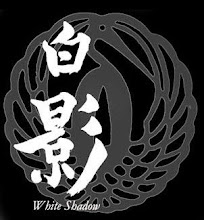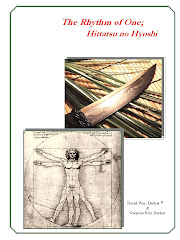
This is the class photo from the Bowie seminar with Pete Kautz instructing. Pete is the 6th person standing from the left. I am the tired old guy in the lower left corner next to me is my training partner aka as my daughter.
Here is the code of conduct that I use for class, whether its kenjutsu, Iaido, or knife fighting.
Edged Weapons Etiquette:
There are certain rules of etiquette that apply to any martial art and some specifically to edged weapons arts. This is true whether you are studying a Western or an Eastern Art. Many schools tend to be very strict regarding these rules and breaches of etiquette are considered a serious lack of respect and a display of ignorance. Therefore, I offer these suggestions (which I give to each new student at my school) as a guideline. Hopefully these will guide you so that if you attend a seminar or train at another school you will not be taken off guard or found lacking in your manners. Remember that these rules come from an age of honor when men lived and died by the sword.
1) The most important rule is that you never touch or pick-up another persons weapon without their explicit permission. Never!
2) Never step over, or on, another person’s weapon (even a training weapon). If the weapon is lying on the floor walk around it. Do not presume to move their weapon without asking and receiving their permission (unless it is in danger of being stepped on by another person.)
3) Do not draw another person’s weapon from its sheath/scabbard without their permission. Given that permission, never pull it out part way and shove it back in. This is a serious insult. It means you did not feel the weapon was worthy of your close examination.
4) Once drawn, Do Not touch the blade without permission and never go swinging the weapon around in mock combat, etc. If it is a folder or a balisong, do not go flicking the blade in and out, over and over again.
5) When transferring an edged weapon from one person to another always pass it handle first. If it is a long weapon, like a sword or large Bowie, it is permissible to hand it over, blade pointing straight up, sharp edge turned toward you. It should be returned to you the same way.
6) If you touched the blade, Do Not re-sheath the weapon with your finger prints all over it. Either ask permission to carefully wipe it down or hand it back to the owner for them to wipe it down.
7) Last and most obvious. Never engage in any horseplay or point any weapon at another person unless you are actively training or sparring with that person, or you intend them harm. For safety sake, be conscious of your blade’s position at all times.
There are certain rules of etiquette that apply to any martial art and some specifically to edged weapons arts. This is true whether you are studying a Western or an Eastern Art. Many schools tend to be very strict regarding these rules and breaches of etiquette are considered a serious lack of respect and a display of ignorance. Therefore, I offer these suggestions (which I give to each new student at my school) as a guideline. Hopefully these will guide you so that if you attend a seminar or train at another school you will not be taken off guard or found lacking in your manners. Remember that these rules come from an age of honor when men lived and died by the sword.
1) The most important rule is that you never touch or pick-up another persons weapon without their explicit permission. Never!
2) Never step over, or on, another person’s weapon (even a training weapon). If the weapon is lying on the floor walk around it. Do not presume to move their weapon without asking and receiving their permission (unless it is in danger of being stepped on by another person.)
3) Do not draw another person’s weapon from its sheath/scabbard without their permission. Given that permission, never pull it out part way and shove it back in. This is a serious insult. It means you did not feel the weapon was worthy of your close examination.
4) Once drawn, Do Not touch the blade without permission and never go swinging the weapon around in mock combat, etc. If it is a folder or a balisong, do not go flicking the blade in and out, over and over again.
5) When transferring an edged weapon from one person to another always pass it handle first. If it is a long weapon, like a sword or large Bowie, it is permissible to hand it over, blade pointing straight up, sharp edge turned toward you. It should be returned to you the same way.
6) If you touched the blade, Do Not re-sheath the weapon with your finger prints all over it. Either ask permission to carefully wipe it down or hand it back to the owner for them to wipe it down.
7) Last and most obvious. Never engage in any horseplay or point any weapon at another person unless you are actively training or sparring with that person, or you intend them harm. For safety sake, be conscious of your blade’s position at all times.






No comments:
Post a Comment